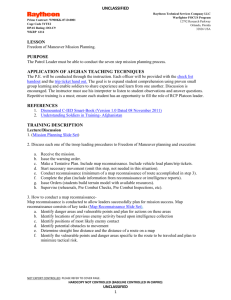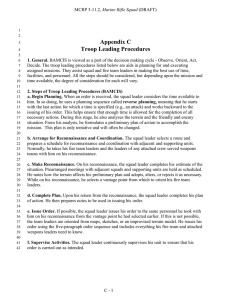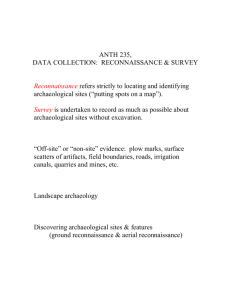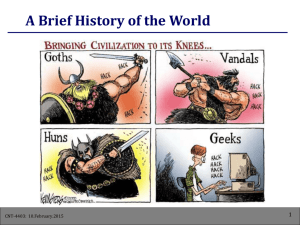Engineering Reconnaissance Chapter 3 Zone Reconnaissance
advertisement
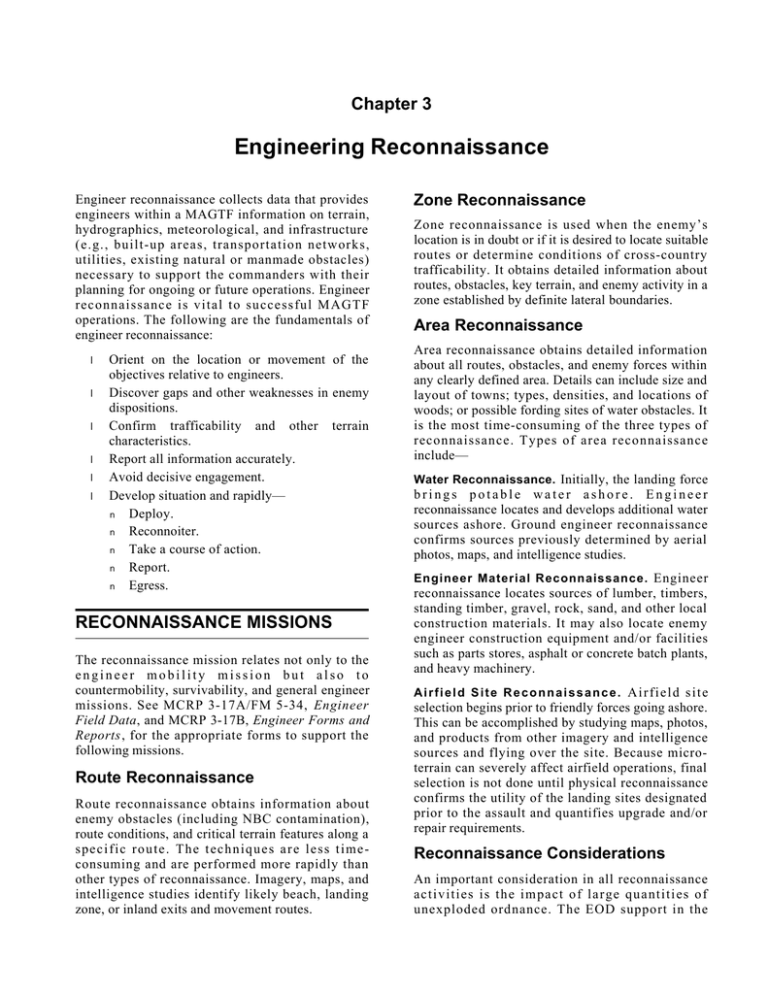
Chapter 3 Engineering Reconnaissance Engineer reconnaissance collects data that provides engineers within a MAGTF information on terrain, hydrographics, meteorological, and infrastructure (e.g., built-up areas, transportation networks, utilities, existing natural or manmade obstacles) necessary to support the commanders with their planning for ongoing or future operations. Engineer reconnaissance is vital to successful MAGTF operations. The following are the fundamentals of engineer reconnaissance: l l l l l l Orient on the location or movement of the objectives relative to engineers. Discover gaps and other weaknesses in enemy dispositions. Confirm trafficability and other terrain characteristics. Report all information accurately. Avoid decisive engagement. Develop situation and rapidly— n Deploy. n Reconnoiter. n Take a course of action. n Report. n Egress. RECONNAISSANCE MISSIONS The reconnaissance mission relates not only to the engineer mobility mission but also to countermobility, survivability, and general engineer missions. See MCRP 3-17A/FM 5-34, Engineer Field Data, and MCRP 3-17B, Engineer Forms and Reports, for the appropriate forms to support the following missions. Route Reconnaissance Route reconnaissance obtains information about enemy obstacles (including NBC contamination), route conditions, and critical terrain features along a specific route. The techniques are less timeconsuming and are performed more rapidly than other types of reconnaissance. Imagery, maps, and intelligence studies identify likely beach, landing zone, or inland exits and movement routes. Zone Reconnaissance Zone reconnaissance is used when the enemy’s location is in doubt or if it is desired to locate suitable routes or determine conditions of cross-country trafficability. It obtains detailed information about routes, obstacles, key terrain, and enemy activity in a zone established by definite lateral boundaries. Area Reconnaissance Area reconnaissance obtains detailed information about all routes, obstacles, and enemy forces within any clearly defined area. Details can include size and layout of towns; types, densities, and locations of woods; or possible fording sites of water obstacles. It is the most time-consuming of the three types of reconnaissance. Types of area reconnaissance include— Water Reconnaissance. Initially, the landing force brings potable water ashore. Engineer reconnaissance locates and develops additional water sources ashore. Ground engineer reconnaissance confirms sources previously determined by aerial photos, maps, and intelligence studies. Engineer Material Reconnaissance. Engineer reconnaissance locates sources of lumber, timbers, standing timber, gravel, rock, sand, and other local construction materials. It may also locate enemy engineer construction equipment and/or facilities such as parts stores, asphalt or concrete batch plants, and heavy machinery. Airfield Site Reconnaissance. Airfield site selection begins prior to friendly forces going ashore. This can be accomplished by studying maps, photos, and products from other imagery and intelligence sources and flying over the site. Because microterrain can severely affect airfield operations, final selection is not done until physical reconnaissance confirms the utility of the landing sites designated prior to the assault and quantifies upgrade and/or repair requirements. Reconnaissance Considerations An important consideration in all reconnaissance activities is the impact of large quantities of unexploded ordnance. The EOD support in the Engineering Operations—MCWP 3-17 MAGTF should be involved in evaluating the impact of this on any mission. Reconnaissance considerations for missions also include— l l Mobility— n Route reconnaissance. Enemy obstacle barrier reconnaissance. n Bypasses identification. l Countermobility— n Barrier Planning. n Target and/or obstacle folders and target analysis. l Survivability— n Friendly forces emplacement. l General Engineering— n Utility assets location. n Water points location. n Local construction identification. n Existing facilities location. l l l The major use of the engineer reconnaissance in the defense is to provide information for the obstacle and/or barrier plan. This information may be obtained forward of the forward edge of the battle area (FEBA), to the rear of the FEBA, or to the flanks. Specific requirements in the defense are— materials l l OFFENSIVE AND DEFENSIVE OPERATIONS l l Engineer reconnaissance in the offense should be placed far enough forward of the maneuver elements perform proper route and obstacle reconnaissance. This must be done in order to return information to the rear in a timely manner. Engineer reconnaissance should have the capability to— l element’s axis of attack. The reports should include estimates for breaching. Provide information on routes along the axis of advance that may influence the commander’s plan such as vulnerabilities and critical choke points. Provide information on water, electric, fuel, and other engineer resources. Locate bypasses far enough in advance of the lead element to prevent slowing the momentum of the maneuver element’s attack. Provide information about the countermobility capability of the enemy. l l l l Provide a detailed report of all existing and reinforcing obstacles along the maneuver 3-2 Detailed information on choke points. Detailed demolition estimates for the creation of obstacles. Resources for obstacle construction. Routes in support of a retrograde or lateral movement. Route reconnaissance on likely avenues of approach for the enemy. Enemy’s breaching capability. Obstacle emplacement in the enemy’s rear capability. Close lanes in obstacles during delay and/or defend operations.
